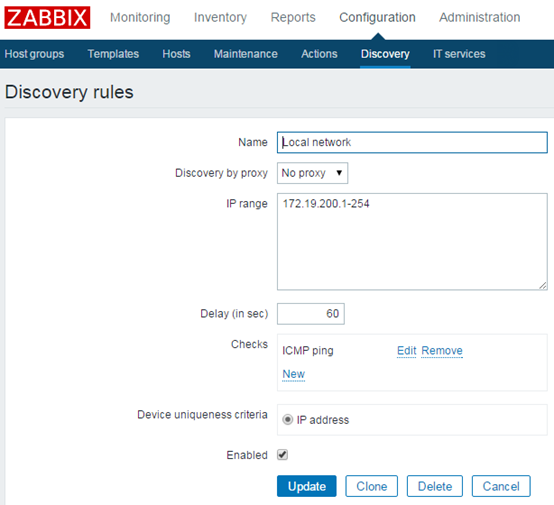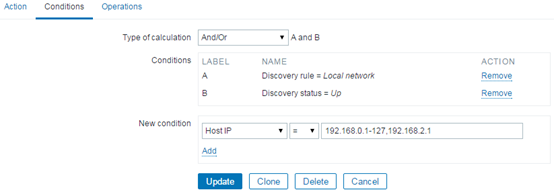Zabbix's fping that automatically detects network conditions
| Introduction | Zabbix automatic discovery function is relatively simple in terms of configuration process: Discovery and Action. When doing Zabbix automatic discovery verification, the automatic discovery function does not take effect when using the "ICMP ping" check method. |
- Zabbix:zabbix-3.0.1server/agent
Found the local network 172.19.200.1-254, Check: ICMP ping, as follows:

In ICMP ping mode, hosts in UP status are added to the "Discovery hosts" group, as follows:

Under the premise that the discovery and action processes of automatic discovery are configured correctly, wait for 10 minutes to observe, and the automatic discovery function will not take effect.
2. Locate the fault# Found that there is an information record of "the /usr/sbin/fping file cannot be found".
[root@localhost ~]# vim /tmp/zabbix_server.log
1412:20160621:110040.593 /usr/sbin/fping: [2] No such file or directory
3. Failure analysis"ICMP ping" check method, use the /usr/sbin/fping command to check the status. If the system is not installed or the fping command execution path is wrong, the check method cannot The device is discovered and the automatic discovery function fails.
three. Install and configure fping 1. Install fping#Compared with ping, fping can ping multiple targets at the same time and has multiple statistical output formats. #fping can currently only be installed through compilation.
[root@localhost ~]# cd /usr/local/src<br>
[root@localhost src]# wget http://www.fping.org/dist/fping-3.13.tar.gz<br>
[root@localhost src]# tar -zxvf fping-3.13.tar.gz<br>
[root@localhost src]# cd fping-3.13<br>
[root@localhost fping-3.13]# ./configure<br>
[root@localhost fping-3.13]# make && make install
#The default fping execution path in the zabbix_server configuration file is commented out. At this time, the default path is: /usr/sbin/fping
#You can configure the execution path of fping as follows:
[root@localhost ~]# sed -i 's|# FpingLocation=/usr/sbin/fping|FpingLocation=/usr/local/sbin/fping|g' /usr/local/zabbix/etc/zabbix_server. conf
#Or do not modify the zabbix_server.conf file, use soft connection ln -s /usr/local/sbin/fping /usr/sbin/fping
3. Configure fping permissions#fping must be executed by the root user. If fping is executed by a non-root account, the following alarm message will appear when viewing the zabbix_server log:
#21822:20160621:151232.024 fping failed: (null): can't create socket (must run as root?) : Permission denied
#If you install fping with the root account, you don’t need to modify the owner
#But zabbix_server uses the zabbix account to call commands. You can set SUID permissions for fping, as follows:
[root@localhost ~]# chown root:root /usr/local/sbin/fping<br>
[root@localhost ~]# chmod u s /usr/local/sbin/fping
Monitoring--> Discovery--> Discovery rule, select "Local network" (name when creating discovery), as follows:

Configuration--> Hosts--> Group, select the "Discovery hosts" group, as follows:

The above is the detailed content of Zabbix's fping that automatically detects network conditions. For more information, please follow other related articles on the PHP Chinese website!

Hot AI Tools

Undresser.AI Undress
AI-powered app for creating realistic nude photos

AI Clothes Remover
Online AI tool for removing clothes from photos.

Undress AI Tool
Undress images for free

Clothoff.io
AI clothes remover

Video Face Swap
Swap faces in any video effortlessly with our completely free AI face swap tool!

Hot Article

Hot Tools

Notepad++7.3.1
Easy-to-use and free code editor

SublimeText3 Chinese version
Chinese version, very easy to use

Zend Studio 13.0.1
Powerful PHP integrated development environment

Dreamweaver CS6
Visual web development tools

SublimeText3 Mac version
God-level code editing software (SublimeText3)

Hot Topics
 1662
1662
 14
14
 1418
1418
 52
52
 1311
1311
 25
25
 1261
1261
 29
29
 1234
1234
 24
24
 Linux Architecture: Unveiling the 5 Basic Components
Apr 20, 2025 am 12:04 AM
Linux Architecture: Unveiling the 5 Basic Components
Apr 20, 2025 am 12:04 AM
The five basic components of the Linux system are: 1. Kernel, 2. System library, 3. System utilities, 4. Graphical user interface, 5. Applications. The kernel manages hardware resources, the system library provides precompiled functions, system utilities are used for system management, the GUI provides visual interaction, and applications use these components to implement functions.
 How to check the warehouse address of git
Apr 17, 2025 pm 01:54 PM
How to check the warehouse address of git
Apr 17, 2025 pm 01:54 PM
To view the Git repository address, perform the following steps: 1. Open the command line and navigate to the repository directory; 2. Run the "git remote -v" command; 3. View the repository name in the output and its corresponding address.
 vscode Previous Next Shortcut Key
Apr 15, 2025 pm 10:51 PM
vscode Previous Next Shortcut Key
Apr 15, 2025 pm 10:51 PM
VS Code One-step/Next step shortcut key usage: One-step (backward): Windows/Linux: Ctrl ←; macOS: Cmd ←Next step (forward): Windows/Linux: Ctrl →; macOS: Cmd →
 What is the main purpose of Linux?
Apr 16, 2025 am 12:19 AM
What is the main purpose of Linux?
Apr 16, 2025 am 12:19 AM
The main uses of Linux include: 1. Server operating system, 2. Embedded system, 3. Desktop operating system, 4. Development and testing environment. Linux excels in these areas, providing stability, security and efficient development tools.
 How to run sublime after writing the code
Apr 16, 2025 am 08:51 AM
How to run sublime after writing the code
Apr 16, 2025 am 08:51 AM
There are six ways to run code in Sublime: through hotkeys, menus, build systems, command lines, set default build systems, and custom build commands, and run individual files/projects by right-clicking on projects/files. The build system availability depends on the installation of Sublime Text.
 How to run java code in notepad
Apr 16, 2025 pm 07:39 PM
How to run java code in notepad
Apr 16, 2025 pm 07:39 PM
Although Notepad cannot run Java code directly, it can be achieved by using other tools: using the command line compiler (javac) to generate a bytecode file (filename.class). Use the Java interpreter (java) to interpret bytecode, execute the code, and output the result.
 laravel installation code
Apr 18, 2025 pm 12:30 PM
laravel installation code
Apr 18, 2025 pm 12:30 PM
To install Laravel, follow these steps in sequence: Install Composer (for macOS/Linux and Windows) Install Laravel Installer Create a new project Start Service Access Application (URL: http://127.0.0.1:8000) Set up the database connection (if required)
 How to use VSCode
Apr 15, 2025 pm 11:21 PM
How to use VSCode
Apr 15, 2025 pm 11:21 PM
Visual Studio Code (VSCode) is a cross-platform, open source and free code editor developed by Microsoft. It is known for its lightweight, scalability and support for a wide range of programming languages. To install VSCode, please visit the official website to download and run the installer. When using VSCode, you can create new projects, edit code, debug code, navigate projects, expand VSCode, and manage settings. VSCode is available for Windows, macOS, and Linux, supports multiple programming languages and provides various extensions through Marketplace. Its advantages include lightweight, scalability, extensive language support, rich features and version




